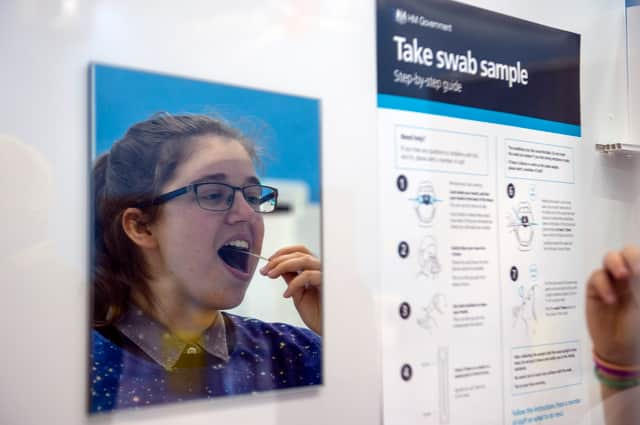Daily Covid testing ‘just as effective’ in controlling transmission as self isolation


Testing school pupils who have been in contact with someone with Covid-19 may be just as effective in controlling transmission as isolating entire groups, a new study suggests.
Research by the University of Oxford estimates that daily testing in secondary schools can cut coronavirus-related illnesses by 39 per cent.
Advertisement
Hide AdAdvertisement
Hide AdTesting as an alternative to quarantine?
Around 200 secondary schools and colleges across England took part in the study, with one group following the national guidance for quarantining close contacts of positive Covid-19 cases for 10 days.
The second group allowed contacts to take rapid lateral flow tests on a daily basis at school over the course of a week instead of having to isolate.
The study, which was sponsored by the Department of Health and Social Care, analysed data from more than 200,000 pupils and 20,000 staff between April and June 2021, with close contacts required to take a PCR test on day two and seven to determine how many people became infected.
The findings showed that only a small percentage - between 1.5 and 1.6 per cent - of pupils and staff tested positive for Covid-19 after close contact with a case in school or college.
Advertisement
Hide AdAdvertisement
Hide AdResearchers found no evidence that the rate of pupils and staff developing coronavirus with symptoms was different in the group carrying out daily tests compared with the group isolating at home.
It is estimated that infections were slightly lower among pupils and staff when daily testing was carried out in schools, by comparison to infections among the group isolating for 10 days.
Of the group carrying out daily tests, only 1.5 per cent of contacts tested positive or indeterminate for Covid-19, while a total of 1.6 per cent of pupils and staff tested positive in quarantine.
Bernadette Young, clinical lecturer in infectious diseases at the University of Oxford and an investigator on the study, said they had expected daily testing to improve transmission control due to the “social penalties” attached to the current 10-day self-isolation policy.
Advertisement
Hide AdAdvertisement
Hide AdDr Young said asking pupils to carry out asymptomatic testing twice a week, as well as naming friends they have been in close contact with, could prevent secondary students from being “more upfront”.She said: “Now if the consequence of you testing positive is that all your friends are put in isolation, there’s a social penalty that goes with that.
“And so the hypothesis was, or the theory was, that if that penalty is lessened because your classmates will still be allowed to attend school, your motivation to testing will change.
“By offering daily testing, you identify more of those who are truly positive and isolate specifically those who are positive, and they’re more likely to withdraw from [social] mixing and decrease the number of infectious cases present in the wider context. So it makes sense that it could happen.”
Reducing Covid school absences
Researchers estimated that allowing pupils and staff to take daily Covid-19 tests can reduce coronavirus-related school absences by 39 per cent.
Advertisement
Hide AdAdvertisement
Hide AdThe findings come after government figures show that more than one million children in England were absent from school last week for coronavirus-related reasons, with 934,000 in isolation due to being a close contact of a positive case.
Tim Peto, professor of medicine at the University of Oxford and principal investigator on the study, advised policymakers to use the study to think about transmission in the workplace compared to schools – and whether employees in other workplaces would be “enthusiastic” about testing.
He said: “Our findings indicate that there is no significant difference in Covid-19 transmission between schools where bubbles were sent into home isolation versus those where daily contact testing was implemented instead.
“Infection rates in the close contacts were low in general, and there was little difference between those who went to school following a negative lateral flow test and those who were isolating at home.”
Advertisement
Hide AdAdvertisement
Hide AdEarlier this month, Education Secretary Gavin Williamson told MPs that secondary schools and colleges will be asked to provide two on-site tests to their students at the start of the autumn term, while regular home testing will continue until at least the end of September.
However, from August 16, children in England will only need to self-isolate if they have tested positive for Covid-19.
Susan Hopkins, chief medical adviser for NHS Test and Trace, added: “This is a major breakthrough, showing that daily contact testing can keep young people in classrooms instead of making them isolate at home.”
“We’ve been trying to find safe alternatives, and this study gives us evidence of safe alternatives to isolation for school contacts.
Advertisement
Hide AdAdvertisement
Hide Ad“So far, self-isolation has been one of the most effective tools at our disposal against Covid-19 – stopping isolated cases from becoming major outbreaks. To have another potential tool like this is great news.”
This article originally appeared on our sister site, NationalWorld.